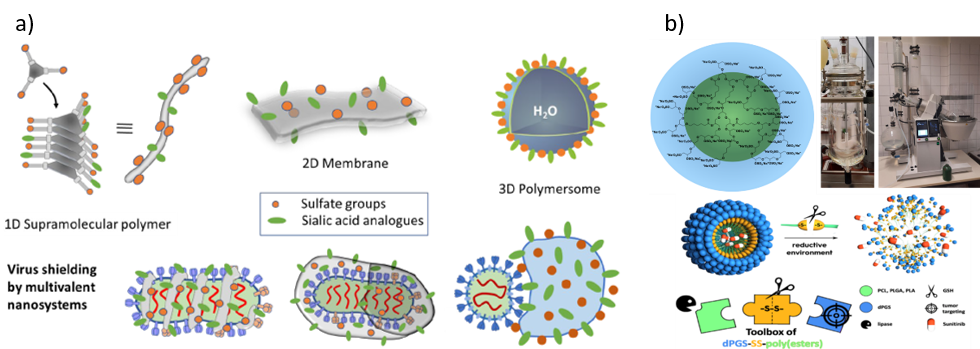Polymeric and Supramolecular Nanosystems
The subgroup “Polymeric and Supramolecular Nanosystems” focus on the self-assembly and self-organization of polyglycerol-based architectures into functional nanosystems and also aims to understand their interaction at the interface of cells by modulating chemical and physical properties for the development of high-performance biomaterials. The supramolecular interactions between polyglycerol systems exhibit the potential to integrate themselves such as nanogels, droplets, fibers or nanosheets with unconventional properties and functions. The polymer design as well as functionalization is connected with the final application orientation, i.e. virus binding and inhibition, cancer therapy, etc. Since charge plays a crucial role in interaction, charge modulating at the surface of synthetic polyglycerol sulfate-based polyelectrolytes can mimic the biological function of heparin and heparin sulfate to avoid the intrinsic risks of heparin. Several methods have been used to determine their aggregation and interaction behavior such as Cryo-TEM, SEM, UV and Fluorescence spectroscopy, Atomic Force Microscopy confocal microscopy etc.
Figure 1

a) Illustration of supramolecular nanosystems and their interactions with different virus morphologies, including shielding of the respective virus surfaces. b) High scale reactor for the synthesis of biodegradable polyglycerol sulfate and the polyanionic micelles for targeted drug delivery.
In drug delivery applications polymers are used either as unimolecular nanocarrier systems or as a building block for supramolecular assemblies such as micelles or vesicles. The polymers are designed in a way to release the drug in response to different stimuli such as enzymatic degradation, acidic conditions, and red-ox environments. The figure shows a polymerization performed in 100 g scale in 5 L reactor to produce biodegradable polymers which can be used for anti-inflammatory and drug delivery purposes.
Publications
- Gao et al., Supramolecular nanogels fabricated via host-guest molecular recognition as penetration enhancer for dermal drug delivery. J. Control. Release, 2019, 300, 64-72.
- Zhong et al., Tumor Microenvironment-Activatable Nanoenzymes for Mechanical Remodeling of Extracellular Matrix and Enhanced Tumor Chemotherapy. Adv. Funct. Mater. 2021, 31, 2007544.
- Lafleur et al., Supramolecular Double Helices from Small C3-Symmetrical Molecules Aggregated in Water. J. Am. Chem. Soc. 2020, 142, 41, 17644.
- Braatz et al., Toolbox of Biodegradable Dendritic (Poly glycerol sulfate)–SS-poly(ester) Micelles for Cancer Treatment: Stability, Drug Release, and Tumor Targeting. Biomacromolecules 2021, 22, 2625.
- Mohammadifar et al., Graphene-Assisted Synthesis of 2D Polyglycerols as Innovative Platforms for Multivalent Virus Interactions. Adv. Funct. Mater. 2021, 31, 2009003.
